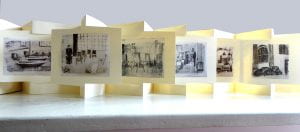Anwyl Cooper-Willis
So far, I have undertaken some preliminary research into the place of sewing within the nineteenth century Bristol Lunatic Asylum. It was opened in 1861, to provide Moral Treatment; an ordered life would aid the recovery of a disordered brain. As well as a plentiful and good diet the hospital provided rest, safety and occupation, in the form of useful occupation which was an important part of the treatment. The curative properties of work had been praised by Samuel Tuke, founder of the York Retreat (1796) and one of the earliest mental health reformers.
The Bristol Asylum was largely self supporting in vegetables, potatoes, pork, clothing and shoes, all from patient’s work. In 1861 50% of women were working, a majority at sewing including dressmaking, hospital uniforms for patients, and mending as well as some ‘fancy sewing’. Reading patient’s medical reports it is clear that ‘Working well at her sewing’ is an indication of improvement. There are also accounts of disruptions by a patient in a room with others who are just getting on.
The hospital’s annual reports contain a lot of information on numbers of women employed at sewing, the value put on their labour, cloth purchases by the hospital for sheets covers and clothing and so on.
My plan is to continue this research into individual patients and the context of the hospital once the Bristol Archives reopens.
I am very excited about this project and the original research it involves. I spent a year as an artist-in-residence at the museum and made some work re-presenting statistics on patient admissions and outcomes. I am keen to further my investigations of how quantitative data can be re-expressed via an art practice.


